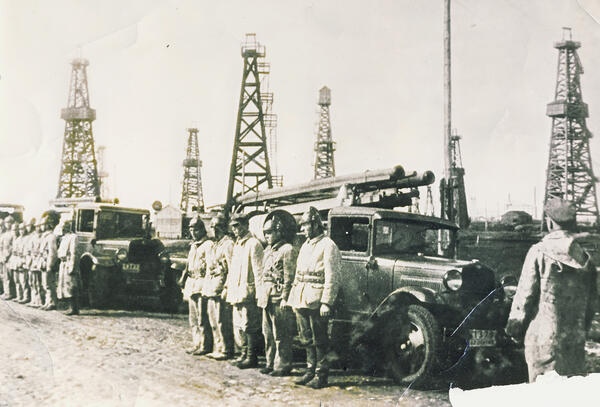The occupational safety standards and environmental regulations of the first half of the 20th century stand no comparison with the modern ones. For instance, in the 1930s, an entire village could be flooded with an oil gusher as a result of oil extraction in the Ishimbay region. It is no wonder that fires were more common in those days as well, and since wood was the main building material at the time, these fires were often quite fierce and destructive. These conditions called for highly mobile, well-equipped, and well-trained fire crews: this photograph depicts precisely such a crew participating in a drill. The rows of drilling rigs visible in the background can give you a clue as to the kind of emergencies the firefighters were training for on that day.
The first organized fire crew was introduced in Ancient Rome. They were known as ‘vigIles, ’ meaning ‘watchmen, ’ as they were on the alert all night long, and even combined firefighting with police duties. The richest Romans even maintained their own fire crews. Nevertheless, for centuries, fires in Russia had to be extinguished by the people themselves: emergencies were announced by the ringing of a bell, which signaled residents of nearby houses to rush to the scene of a fire and help put it out. A panicked crowd would often be more of a hindrance than a help to the extinguishing of fires: it was clear that a small group of trained specialists would be much more effective at dealing with fires. For this reason, in 1803, Emperor Alexander the First ordered to establish the country’s first fire crew.
Nowadays, every city has a dedicated fire department. Modern firefighters utilize a variety of powerful types of equipment, including firetrucks and fireboats, special firefighting trains, fire proximity suits, as well as a multitude of different extinguishing agents. The training of the firefighters themselves does not lag behind, as stopping fires requires them not only to make use of the latest technological advances but also be able to properly assist the injured, calm people down, and help fire victims escape from burning buildings. At the same time, their own safety is the last thing firefighters have on their minds, which is why the profession of a firefighter is considered one of the most dangerous in the world and demands great dedication, fearlessness, courage, and willpower.
It is also worth noting that various interpretations regarding the difference between the two Russian words used to refer to firefighters—"pozharny’ and “pozharnik"—are merely a linguistic myth. At least, authors of modern Russian dictionaries insist that both of these words have the same meaning.
The first organized fire crew was introduced in Ancient Rome. They were known as ‘vigIles, ’ meaning ‘watchmen, ’ as they were on the alert all night long, and even combined firefighting with police duties. The richest Romans even maintained their own fire crews. Nevertheless, for centuries, fires in Russia had to be extinguished by the people themselves: emergencies were announced by the ringing of a bell, which signaled residents of nearby houses to rush to the scene of a fire and help put it out. A panicked crowd would often be more of a hindrance than a help to the extinguishing of fires: it was clear that a small group of trained specialists would be much more effective at dealing with fires. For this reason, in 1803, Emperor Alexander the First ordered to establish the country’s first fire crew.
Nowadays, every city has a dedicated fire department. Modern firefighters utilize a variety of powerful types of equipment, including firetrucks and fireboats, special firefighting trains, fire proximity suits, as well as a multitude of different extinguishing agents. The training of the firefighters themselves does not lag behind, as stopping fires requires them not only to make use of the latest technological advances but also be able to properly assist the injured, calm people down, and help fire victims escape from burning buildings. At the same time, their own safety is the last thing firefighters have on their minds, which is why the profession of a firefighter is considered one of the most dangerous in the world and demands great dedication, fearlessness, courage, and willpower.
It is also worth noting that various interpretations regarding the difference between the two Russian words used to refer to firefighters—"pozharny’ and “pozharnik"—are merely a linguistic myth. At least, authors of modern Russian dictionaries insist that both of these words have the same meaning.



